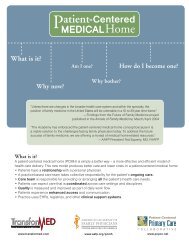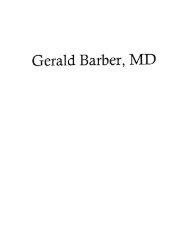New Drug Update 2009-2010 - LAFP
New Drug Update 2009-2010 - LAFP
New Drug Update 2009-2010 - LAFP
Create successful ePaper yourself
Turn your PDF publications into a flip-book with our unique Google optimized e-Paper software.
CONTRAINDICATIONS: Febuxostat will be contraindicated in patients with a history of hypersensitivity to<br />
febuxostat and the other product ingredients. Febuxostat is also contraindicated in patients receiving<br />
azathiaprine, mercaptopurine and theophylline, these agents are metabolized by xanthine oxidase and<br />
thus levels would be significantly elevated..<br />
WARNINGS AND PRECAUTIONS: As with allopurinol, periodic liver function tests may be advisable for<br />
patients receiving febuxostat.<br />
Febuxostat is not effective for the treatment of acute gouty attacks. Acute gouty attacks may be<br />
precipitated at the start of treatment with febuxostat in new patients and these may continue even after<br />
serum uric acid concentrations begin to fall, usually for the first 6 to 12 months. Colchicine has often been<br />
coadministered during this time.<br />
Cardiovascular events? A higher rate of CV and thromboembolic events was seen in the head to head<br />
trials against allopurinol and patients should be monitored for signs of MI and stroke. A causal<br />
relationship with febuxostat has not been established. Anti-Platelet Trialists’ Collaborative (APTC)<br />
endpoints (CV death, non-fatal MI and non-fatal CVA) events per 100 patient-years of exposure were as<br />
follows placebo 0, febuxostat 40mg 0, febuxostat 80 mg 1.09 and allopuriniol 0.60<br />
ADVERSE REACTIONS: Adverse reactions reported during febuxostat therapy included liver function<br />
test abnormalities, diarrhea, headache, nausea, flushing, dizziness, and gout flares. The concomitant use<br />
of colchicine for acute gout flares may have influenced the overall nature of the adverse reactions.The<br />
overall incidence of adverse reactions was similar in the febuxostat and allopurinol groups in the<br />
comparative study.<br />
Febuxostat 80 and 300 mg doses were not associated with a change in QT interval in a crossover<br />
comparison with placebo and moxifloxacin enrolling 44 healthy subjects.<br />
DRUG INTERACTIONS: Febuxostat is a significant xanthine oxidase inhibitor and would be expected to<br />
significantly inhibit the metabolism of agents that are metabolized by this enzyme (IE azathioprine,<br />
mercaptopurine and theophyllin).<br />
In vitro, febuxostat exhibited no effect on CYP1A2, CYP2C9, CYP2C19, or CYP3A4, and weak inhibitory<br />
activity on CYP2D6. When febuxostat was administered with desipramine (a CYP2D6 substrate) in 18<br />
CYP2D6 extensive metabolizers, a slight increase in total exposure to desipramine was observed. The<br />
effect did not appear clinically important; therefore, dose adjustments do not appear necessary when<br />
CYP2D6 substrates are coadministered with febuxostat.<br />
RECOMMENDED MONITORING: Periodic liver function tests may be advised in addition to monitoring of<br />
serum uric acid.<br />
DOSING: Febuxostat is administered orally once daily at a starting dose of 40 mg once a day. For<br />
patients who do not achieve a serum uric acid of less than 6.0 mg/dl after 2 weeks the dose may be<br />
increased o 80 mg once a day. Febuxostat can be administered without regard to food. No dosage<br />
adjustment is need for mild to moderate renal or hepatic dysfunction.<br />
PRODUCT AVAILABILITY/COST and STORAGE: An NDA for febuxostat 80 and 120 mg was submitted<br />
to the Food and <strong>Drug</strong> Administration (FDA) in December 2004. The FDA approved the 40 and 80 mg<br />
tablets. The cost of Uloric is $5.62 per 40 and 80 mg tablets AWP vs. $0.59 per allopurinol 300 mg<br />
tablets.<br />
CONCLUSION: Febuxostat offers an alternative to allopurinol. Additional studies are necessary to<br />
compare febuxostat with recommended allopurinol doses, although serum uric acid levels were reduced<br />
to a greater extent with febuxostat compared with low-dose allopurinol. Additional side effect information<br />
is necessary to better determine the place of febuxostat in the treatment of hyperuricemia and gout.<br />
Lijmited data suggest that with a different chemical structure that it may be safe to use in patients<br />
intolerant to allopurinol.<br />
50

















